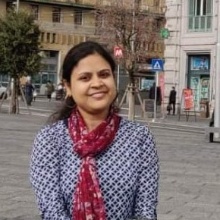Since October, physicist Dr. Monika Rai from India has been doing research at the Institute for Photovoltaics at the University of Stuttgart within the framework of a two-year Alexander von Humboldt research fellowship for postdocs. Actually, the research stay was planned to start one year earlier, but it was delayed due to the pandemic.
At first, she found accommodation in the guest house of the University of Stuttgart, says Monika Rai. Now she is living in Stuttgart. She is always happy to make the trip to the Vaihingen Campus, where the Institute for Photovoltaics is located. The colleagues made her feel welcome, and then there is - of course - the research that the multicultural team of Prof. Dr. Michael Saliba, who is the head of the institute, is conducting: Here, new solar cells and modules are being modeled and manufactured, and the scientists are working on the improvement of silicon-based photovoltaics.
Efficient and stable solar cells
In India, Monika Rai completed her Master’s degree in physics at the Banaras Hindu University in Varanasi, followed by doctoral degree studies in the field of rare earth spectroscopy. Before her way led her to the University of Stuttgart, she worked as a postdoc at the Nanyang Technological University in Singapore. There, she worked on semi-transparent perovskite solar cells and modules for four years. “Photovoltaics is a very promising field of research,” Monika Rai emphasizes. With her work, she aims to improve the efficiency and stability of solar cells. She is particularly interested in all processes that are required in perovskites for the conversion of the entire energy of the solar spectrum and for an efficient absorption.
Perovskite solar cells
“Today’s solar modules are mainly made from silicon,” Monika Rai explains. She goes on to say: “Perovskites are a promising alternative. These organic-inorganic hybrid materials have the advantage that they can be produced easily and inexpensively in the laboratory.” While silicon cells primarily convert the red and infrared radiation of sunlight into electricity, perovskites also use the visible light spectrum.” The researchers therefore expect great potential from silicon-perovskite tandem solar cells, which can absorb many frequencies of the light spectrum and achieve a high efficiency. The current problem of the “newcomer perovskites” in the photovoltaics sector is still their instability. High temperatures and humidity cause their ability to convert sunlight into electrical energy to dwindle.
At the Institute for Photovoltaics at the University of Stuttgart, Monika Rai found excellently equipped laboratories, she says. This is not surprising, as “excellent” basic research is conducted here. For the project LOCAL-HEAT, the head of the institute, Prof. Michael Saliba, received the ERC Starting Grant, which is funded by the European Research Council (ERC) and is valued at EUR 1.5 million. In the manufacturing of thin perovskite layers, this research project relies on light to control the phase transition from liquid to solid in such a way that homogeneous layers are produced.
A growing field of research
“Solar cells – the conversion of solar energy into electricity – is a growing field in which I would like to continue working,” says Monika Rai. After her time at the University of Stuttgart, she can well imagine continuing to work in this promising research field in Europe. “The efficiency of the perovskite cells has increased from 5 to 26 percent in the past ten years,” she explains and estimates that, in the next ten years, the cells may make it to industrial production.
In her spare time, she likes to visit museums or to go jogging in the recreation areas around Stuttgart. Opportunities to meet friends and acquaintances are still somewhat limited due to the pandemic. However, Monika Rai, who lives in Stuttgart, is happy that she and her husband have already had the chance to see quite a bit of the state capital in the course of the city tour offered by the Welcome Center. Her husband works in Belgium. Many a weekend trip therefore also leads to the neighboring country.




